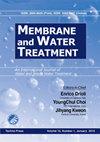去中心化脱矿厂纳滤膜解剖
IF 1.1
4区 工程技术
Q4 ENGINEERING, CHEMICAL
引用次数: 7
摘要
2014年,第一个利用纳滤(NF)膜与可再生能源相结合的脱矿工厂在摩洛哥Kenitra的Sidi Taibi的Al Annouar高中建成。该项目揭示了由于膜污染导致膜性能损失(压力增加、通量下降、采出水水质变差、能耗增加)的困难。为了解决这个问题,对膜进行了解剖,以确定污染的性质和来源。利用扫描电子显微镜(SEM)、能量色散x射线(EDX)检测系统和x射线衍射仪(XRD)对膜和污垢样品进行了扫描电镜分析。此外,在一次清洗步骤中测试和评估了三种清洗溶液(盐酸、硝酸和硫酸),以找到适合污染膜的清洗溶液,以恢复其初始渗透性和性能。实验结果分析表明,污染层主要由碳酸钙(无机污染)组成。结果还表明,采用pH=3的盐酸清洗可提高渗透率,清洗效率达93%。硝酸(pH=3)的清洗效率不超过75%,硫酸(pH=3)的清洗效率不超过40%。本文章由计算机程序翻译,如有差异,请以英文原文为准。
Autopsy of Nanofiltration membrane of a decentralized demineralization plant
In 2014, the first demineralization plant, using nanofiltration (NF) membrane coupled with renewable energies was realized at Al Annouar high school of Sidi Taibi, Kenitra, Morocco. This project has revealed difficulties related to the membrane performances loss (pressure increase, flux decline, poor water quality of the produced water and increase of energy consumption), as consequences of membrane fouling. To solve this problem, an autopsy of the membrane was done in order to determine the nature and origin of the fouling. The samples of membrane and fouling were then analyzed by scanning electron microscopy using a scanning electron microscope (SEM) connected with an energy dispersive X-ray (EDX) detection system and X-ray diffractometer (XRD). Moreover, three cleaning solutions (hydrochloric acid, nitric acid and sulfuric acid) were tested and assessed in a single cleaning step to find the suitable one for the fouled membrane to regain its initial permeability and performances. The analysis of the experimental results showed that the fouling layer is mainly composed of calcium carbonate (inorganic fouling). Results showed also that the permeability is improved by the hydrochloric acid cleaning (pH=3) with a cleaning efficiency of 93%. Cleaning efficiency did not exceed 75 % with nitric acid (pH=3) and 40 % with sulfuric acid (pH= 3).
求助全文
通过发布文献求助,成功后即可免费获取论文全文。
去求助
来源期刊

Membrane Water Treatment
ENGINEERING, CHEMICAL-WATER RESOURCES
CiteScore
1.90
自引率
30.00%
发文量
0
审稿时长
>12 weeks
期刊介绍:
The Membrane and Water Treatment(MWT), An International Journal, aims at opening an access to the valuable source of technical information and providing an excellent publication channel for the global community of researchers in Membrane and Water Treatment related area. Specific emphasis of the journal may include but not limited to; the engineering and scientific aspects of understanding the basic mechanisms and applying membranes for water and waste water treatment, such as transport phenomena, surface characteristics, fouling, scaling, desalination, membrane bioreactors, water reuse, and system optimization.
 求助内容:
求助内容: 应助结果提醒方式:
应助结果提醒方式:


